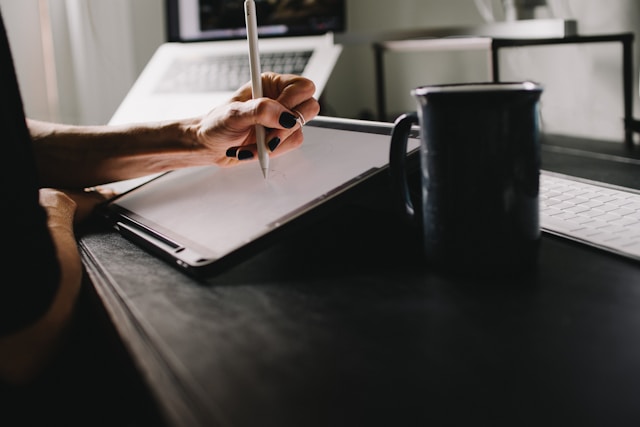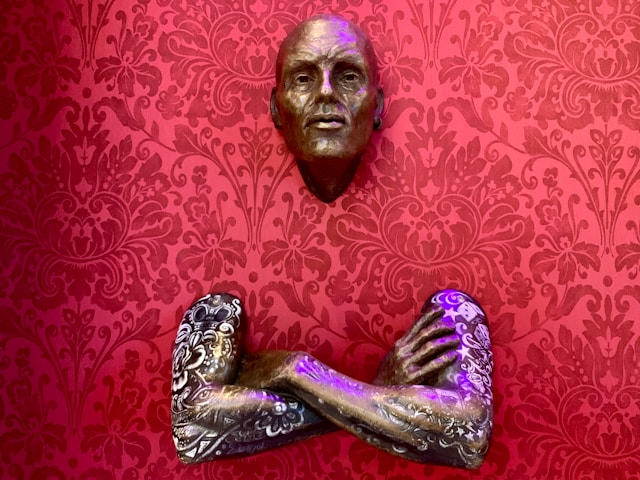In the course of this article, you’re going to learn, step by step, how to draw Goku in a full-body pose using just a pencil. We’ll break it down into easy-to-follow stages, perfect for beginners who are just starting their artistic journey or Dragon Ball fans eager to bring their favorite Saiyan to life on paper.
Step 1: Laying the Foundation with Basic Shapes
Alright, let’s get started! Don’t worry about perfection at this stage; we’re just building the skeleton of our drawing. Think of it like constructing a mannequin before you put clothes on it.
First, lightly sketch a vertical oval. This will be the torso of Goku. It doesn’t have to be a perfect oval – a slightly irregular shape is fine, as long as it’s roughly symmetrical. Imagine this oval as the central mass of his body.
Next, above the torso, draw a smaller circle for the head. The size relationship between the head and the torso is important for getting the proportions right, so aim for the head to be noticeably smaller than the torso. Connect the head to the torso with a short, curved line for the neck. Remember, Goku has a pretty thick neck, so don’t make it too slender.
Now, for the limbs. These will start as simple lines and ovals. For the arms, imagine two sausages extending from the sides of the torso. The upper arm can be represented by a slightly thicker, angled oval, and the forearm by a slightly thinner, also angled oval. Think about the pose you want Goku to be in. For a dynamic pose, maybe one arm is bent at the elbow, ready to strike, while the other hangs more loosely. Lightly sketch these arm segments.
Similarly, for the legs, start with two longer ovals extending downwards from the bottom of the torso. The thigh can be a bit thicker and the calf slightly thinner. Again, consider the pose. Is he standing firmly? Is he leaping into action? Sketch these leg segments lightly, paying attention to the angles of the knees and ankles. At the very bottom of these leg lines, add simple shapes for the feet – maybe just rough triangles or elongated ovals for now.
Remember, these initial shapes are just guides. Don’t press too hard with your pencil, as we’ll be erasing these lines later. The goal here is to establish the overall pose, proportions, and balance of your Goku drawing. Take your time and don’t be afraid to adjust these basic shapes until you’re happy with the initial layout.
Step 2: Refining the Torso and Adding Muscle Structure
Now that we have the basic framework, let’s start adding some muscle definition to Goku’s torso. This is where he starts to look less like a mannequin and more like the powerful Saiyan we know.
Look at your initial oval for the torso. We’re going to round out the shoulders, creating a broader upper body. Imagine two smaller, slightly overlapping ovals on either side of the top of the main torso oval. These will form the deltoid muscles.
Next, think about the chest. Goku has well-defined pectoral muscles. You can suggest these by drawing two slightly curved shapes within the upper part of the torso oval, meeting in the center. Don’t make them too sharp or angular at this stage; aim for a smooth, rounded appearance.
Moving down, consider the abdominal muscles. These can be tricky, but we can simplify them for now. Lightly sketch a few horizontal lines across the lower part of the torso oval to indicate the general areas of his abs. You can then refine these later with more curved lines to show the individual muscle groups. Remember, the lighting in your final drawing will also play a big role in defining these muscles.
Pay attention to the waist as well. Goku’s waist tapers in slightly below the ribcage before flaring out again at the hips. You can adjust the sides of your initial torso oval to reflect this shape.
As you refine the torso, constantly compare it to reference images of Goku. Notice how the muscles flow and connect. Don’t try to draw every single muscle fiber right now; focus on the major muscle groups and their overall shapes. Keep your lines light and be prepared to erase and redraw as you go. This stage is all about building the underlying form of Goku’s powerful physique.
Step 3: Shaping the Arms and Hands
With the torso taking shape, let’s move on to the arms. We’ll build upon those initial sausage-like shapes we drew earlier.
Starting with the upper arm, begin to round out the oval, making it more cylindrical but still slightly tapered towards the elbow. Think about the bicep and tricep muscles. You can suggest the bicep on the front of the upper arm with a slightly bulging curve and the tricep on the back with a similar but perhaps less pronounced curve.
At the elbow joint, make a smooth transition to the forearm. The forearm also has muscles, particularly the brachioradialis on the thumb side and the wrist flexors and extensors. You can suggest these by slightly bulging the sides of the forearm oval. Notice how the forearm often tapers down towards the wrist.
Now for the hands. Hands can be one of the most challenging parts of the human (or Saiyan!) anatomy to draw. For now, let’s simplify them. Think of the palm as a rough square or slightly elongated shape at the end of the forearm. The fingers can be represented by simple cylinders extending from the palm. Pay attention to the overall gesture of the hand. Is it clenched into a fist? Is it open? The basic shapes will depend on the pose.
Don’t worry about the individual fingers or fingernails just yet. We’ll add those details later. The focus here is on getting the overall shape and proportion of the hand correct in relation to the arm.
Remember to consider the perspective and foreshortening if the arms are reaching towards or away from the viewer. This might mean that some parts of the arm or hand appear shorter or wider than they actually are. Keep your lines light and continue to refine the shapes until they look natural and powerful.
Step 4: Sculpting the Legs and Feet
Just like the arms, we’ll now take those basic leg shapes and give them some Saiyan muscle definition.
Starting with the thigh, begin to round out the initial oval, making it more cylindrical. Think about the quadriceps on the front and the hamstrings on the back. You can suggest these muscles with subtle curves along the sides of the thigh. The inner thigh also has muscles, so don’t make this area too flat.
At the knee joint, make a smooth transition to the calf. The calf muscles are quite prominent, especially the gastrocnemius (the main calf muscle). You can show this with two bulging curves on the back of the calf, meeting at the Achilles tendon near the ankle. The front of the lower leg, the tibia, is relatively straight. Notice how the calf often tapers down towards the ankle.
Now for the feet. We started with simple shapes, and now we’ll give them more form. Think of the foot as having a few basic parts: the heel, the arch, and the toes. You can start by defining the heel as a slightly rounded shape at the back. The arch rises from the heel towards the ball of the foot. The toes can still be simplified at this stage, perhaps as a series of small, connected ovals or a single, rounded shape indicating the general toe area.
Consider the pose of the feet. Are they flat on the ground? Are they angled? The shape will change depending on the perspective. If Goku is in mid-air, the feet might be pointed or flexed.
Again, don’t worry about the individual toes or toenails yet. Focus on the overall shape and proportion of the feet in relation to the legs and the rest of the body. Keep your lines light and be prepared to make adjustments as you go.
Step 5: Adding Goku’s Iconic Hairstyle
Now for one of Goku’s most recognizable features: his spiky hair! This can seem intimidating at first, but if you break it down into smaller sections, it becomes much more manageable.
First, lightly sketch the overall outline of his hair. Think of it as a series of large, upward-pointing tufts. There’s usually a central mass of hair that sweeps back and then several distinct spikes radiating outwards and upwards. Pay attention to the volume of the hair; it’s quite substantial.
Within this overall shape, start to define the individual spikes. These aren’t perfectly straight; they often have slight curves and come to sharp points. Notice how some spikes overlap others, creating depth and dimension.
Goku’s hairline is also important. It typically dips down in the middle of his forehead, forming a kind of widow’s peak. Lightly sketch this hairline.
Don’t try to draw every single strand of hair. Instead, focus on the major clumps and the overall silhouette. Think about the direction in which the hair flows. It generally moves upwards and outwards from the top of his head.
Keep your lines relatively loose and dynamic when drawing the hair to capture its energy and movement. You can always tighten up the lines later. Remember to compare your drawing to reference images to get the shape and arrangement of the spikes as accurate as possible. This is a key element in making your drawing instantly recognizable as Goku.
Step 6: Sketching the Facial Features
With the head and hair in place, it’s time to add Goku’s distinctive facial features. Placement is key here, so lightly mark out some guidelines on the face. A vertical line down the center of the face and a horizontal line across the middle (for the eyes) can be very helpful.
Goku’s eyes are typically large and expressive. They are usually drawn with sharp, angular shapes. Start by sketching the upper and lower eyelids. The upper eyelid often has a more pronounced curve. The pupils are usually drawn as dark ovals or circles. Don’t forget to add a small highlight in each pupil to give them a sense of life. Goku’s eyebrows are often thick and angled, conveying his determined or sometimes intense expressions.
His nose is usually relatively small and simple, often depicted with just a few lines to suggest the bridge and the tip. The mouth can vary depending on the expression you want to capture. It can be a simple straight line for a neutral expression, a wider curve for a smile, or more angular lines for a shout or yell.
Pay attention to the spacing between the features and their size relative to the face. Use your guidelines to ensure everything is in the right place. Lightly sketch these features first, and then you can refine the lines and add more detail later.
Remember to consider the angle of the head. If the head is turned, the placement and perspective of the facial features will change. Reference images from the same angle can be very helpful here.
Step 7: Defining the Clothing
Now let’s clothe our Saiyan! Goku’s most iconic outfit is his orange and blue gi. We’ll start by outlining the basic shapes of his top and pants.
The top is usually a loose-fitting, sleeveless vest. Follow the contours of the torso you’ve already drawn to define the edges of the vest. Pay attention to the neckline, which is typically a simple, rounded shape. The bottom of the vest usually ends around the hips.
The pants are also loose-fitting and often have a slightly baggy appearance. Start by drawing lines that follow the general shape of the legs you’ve already sketched, but give them more volume. The pants usually gather slightly at the ankles or are tucked into boots.
Goku often wears a belt or sash around his waist. Draw this as a band that wraps around the middle of his torso, over the top of his pants and under his vest.
He also wears wristbands and boots. The wristbands are usually simple, thick bands around his wrists. The boots are often depicted as having a distinct shape with some detailing.
As you draw the clothing, think about how it drapes and folds on the body. Where would there be wrinkles or creases? For example, there might be folds around the shoulders and armholes of the vest, and wrinkles around the knees and ankles of the pants. Lightly suggest these folds with curved lines.
Don’t get bogged down in too much detail at this stage. Focus on getting the overall shapes and the way the clothing fits on the body correct. We’ll add more details like seams and the symbols on his gi later.
Step 8: Adding Details and Refining Lines
This is where we start to bring our drawing to life by adding those finer details that make Goku instantly recognizable.
Let’s start with the face. Refine the lines of the eyes, making them sharper and more defined. Add details like the inner corners of the eyes and the thickness of the eyelids. Darken the pupils and make sure the highlights are clear. Shape the eyebrows more precisely, giving them the characteristic Goku angle. Refine the nose and mouth, adding any subtle curves or lines that define his expression. You can also add subtle lines around the nose and mouth to suggest the underlying structure.
Moving to the hair, go over the initial spikes and make them more defined and sharp. Add smaller, thinner spikes in between the larger ones to create more volume and texture. You can also add some subtle curved lines within the larger spikes to suggest the flow of the hair.
Now let’s focus on the clothing. Define the edges of the vest, pants, belt, wristbands, and boots more clearly. Add details like the seams on the clothing. Goku’s gi often has a symbol on the front and back. Make sure you get this symbol right. It can vary depending on the point in the Dragon Ball series, so refer to your reference material. Add more definition to the folds and wrinkles in the clothing to give it a more realistic and dynamic look.
Look at the muscles you sketched earlier and refine their shapes. Add more subtle curves and lines to suggest the different muscle groups. Think about how the light would fall on his body and lightly sketch in areas of shadow. This will add depth and dimension to your drawing.
Finally, go over all your initial sketch lines and erase any that are no longer needed. Darken the lines that you want to keep, varying the pressure of your pencil to create thicker and thinner lines. This can help to emphasize certain areas and create a more visually interesting drawing.
Take your time at this stage and pay attention to the small details. These are what will elevate your drawing and make it truly stand out.
Step 9: Shading and Adding Depth
Shading is crucial for making your drawing look three-dimensional. It adds volume and form to Goku’s body and clothing.
First, determine your light source. Imagine where the light is coming from in your scene. This will dictate where the shadows fall. Areas that are facing the light will be brighter, while areas that are turned away from the light will be in shadow.
Start by applying light layers of shading to the areas that are in shadow. You can use the side of your pencil to create smooth, even tones. Gradually build up the darkness in the areas of deepest shadow.
Consider the different surfaces of Goku’s body and clothing. Muscles will often have rounded highlights and shadows that follow their form. Clothing will have folds and wrinkles that create areas of light and shadow.
Pay attention to the transitions between light and shadow. These transitions can be soft and gradual or sharp and defined, depending on the intensity of the light and the shape of the object.
You can use different shading techniques to create different effects. Hatching (using parallel lines) and cross-hatching (using intersecting lines) can add texture and depth. Blending your shading with a blending stump or even your finger (be careful not to smudge too much!) can create smooth transitions.
Don’t be afraid to go back and add darker shadows or lighter highlights as needed. Shading is often an iterative process. Continuously compare your drawing to your reference material to see where the shadows and highlights fall.
Remember that the hair also has highlights and shadows. The spiky nature of Goku’s hair will create many small areas of shadow.
Take your time with the shading. It can make a huge difference in the overall look and feel of your drawing.
Step 10: Final Touches and Cleanup
This is the final stage where you step back and look at your drawing with a critical eye. Are there any areas that need further refinement?
Check all your lines. Are they clean and crisp where they need to be? Erase any stray lines or smudges. You might want to go over some of the outlines with a slightly darker pencil to make them stand out more.
Look at your shading. Is there enough contrast between the light and dark areas? Are the transitions smooth where they should be? Add any final touches to the shading to enhance the three-dimensional effect.
Consider adding subtle details that you might have missed, such as the texture of the clothing or small details in the hair.
If you’re happy with your drawing, you can consider inking it to make the lines permanent and then erasing the pencil lines completely. However, this is optional and depends on your personal preference.
Finally, sign your artwork! You’ve put in the effort to create this drawing, so don’t forget to put your mark on it.
Congratulations! You’ve now drawn a full-body portrait of Goku with a pencil, step by step. Remember that practice makes perfect, so don’t be discouraged if your first attempt isn’t exactly how you envisioned it. Keep drawing and you’ll continue to improve.
Frequently Asked Questions (FAQ)
What are the best pencils for drawing Goku?
For beginners, a set of graphite pencils with varying hardness (e.g., HB, 2B, 4B) is a great starting point. Softer pencils (like 4B) are good for darker lines and shading, while harder pencils (like HB) are better for light sketching and details. As you progress, you might want to explore more specialized drawing pencils.
What kind of paper is best for pencil drawing?
Smooth or slightly textured drawing paper is generally good for pencil work. Avoid paper that is too rough, as it can make it difficult to achieve smooth shading. Heavier weight paper is also recommended as it can withstand more erasing and layering without tearing.
How do I get the proportions right?
Proportions can be tricky, but using basic shapes as a foundation, as we discussed in Step 1, is crucial. Constantly compare the different parts of the body to each other and to reference images. Don’t be afraid to measure (visually or even with your pencil) to check if the head is the right size relative to the torso, for example.
How can I improve my shading techniques?
Practice different shading techniques like smooth blending, hatching, and cross-hatching. Experiment with different levels of pressure on your pencil to create varying tones. Observing how light and shadow fall on real objects or reference images is also very helpful.
Where can I find good reference images of Goku?
You can find plenty of reference images online through image searches. Look for clear, well-lit images that show the pose and details you want




